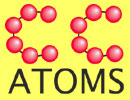
 |
| Home | About | Software | Curriculum | Research |
| Contents of About: About the Project | Proposal |
Home Page ![]() About CC-ATOMS
About CC-ATOMS ![]() Proposal
Proposal ![]() ITR Proposal: Need
ITR Proposal: Need
| Proposal Contents: |
THE NEED
We see an opportunity to combine an advanced Molecular Workbench
model with Pedagogica and WISE to address an important
educational problem: the growing gap between science and technology
in the nation's two-year college technical programs.
The central role of American two-year colleges in American education
is too often overlooked. They provide a pathway to advancement
for adults, as well as for the unemployed, veterans, immigrants,
welfare mothers, and the poor. Two-year colleges currently enroll
42% of all first time college students as well as 46% of all minority
students in higher education. Close to half of all students, furthermore,
who attend four-year colleges, begin their studies at two-year
colleges (Foote 1997). Many two-year college students enter specialty
programs in preparation for technical careers in areas such as
health, biotechnologies, photonics, networking, and avionics.
Health professions and related sciences and engineering are among
the four most popular degrees areas. Significant numbers of science
teachers are trained in two-year colleges (Adelman, 1997).
Two-year colleges are far more affordable than most colleges and
universities, not only because their tuition is lower, but also
because students usually commute, saving the costs of room and
board. After only two years, their technical programs promise
a job that usually represents a significant advance in pay, security,
advancement potential, and satisfaction. This pathway to employment
is in such stark contrast to the liberal arts BA that many college
graduates go on to enroll in two-year technical programs in order
to earn a marketable skill. (See, for example, Baker, et al, 1994;
Grubb, 1996)
Two-year colleges offer an amazing range of technical programs.
For instance, Austin Community College's Allied Health program
offers specialties such as Medical Laboratory Technology, Pharmacy
Technician, and Phlebotomy Technician .
There are increasing demands on courses in technical programs
at the two-year colleges. Students must learn more every year,
the content is increasingly complex, and technologies are always
advancing. Pressure is felt on basic science courses to equip
students with more fundamental content and on specialty programs
to provide more particular content. In the little time available
in a two-year program, there is a tendency for the gap to widen
between the fundamental science that can be taught and student
understanding of the applications of science on which many technologies
are based. While more employers are collaborating with educational
institutions, they often have their own agendas, and the distance
from learning core science increases (NSF, 1996).
Our approach of using serious science models that have been embedded
in scaffolded learning activities can help bridge this gap. It
can do this by connecting the real world many of these students
will encounter in their applied work with fundamental science
concepts in ways that were never before possible. These computational
models can help students acquire powerful mental models as they
work their way, through investigations that capture the qualitative
features of complex systems, without the need for extensive abstract
theory or advanced mathematics. Having acquired these powerful
mental models, students can then better understand the core concepts
in their field, better address problems that they encounter on
the job, and better equip themselves to understand new technologies
that will inevitably be adopted in the near future.
A solid understanding of atoms, molecules, and their interactions
allows students to grasp what lies at the heart of modern biology,
chemistry, and physics. That same understanding will assist them
in the technical specialties taught at two-year colleges. Ensembles
of interacting atoms and molecules determine many thermal, chemical,
and biological phenomena that technical students will encounter
such as phase change, diffusion, osmosis, solubility, surface
tension, equilibria, reactions, catalysis, biological specificity,
hydrophobicity, and self-assembly. A solid, intuitive understanding
of these phenomena would be most helpful to students in many technical
fields. For instance, medical technicians handling a new dialysis
machine will do better to understand osmosis, which has a simple
atomic-scale explanation. Even students in cosmetology might profit
from realizing that cell turgor depends on the same phenomenon.
Students training for work with electrophoresis, to take another
example, will be more competent if they understand the atomic
basis of molecular migration.
 The relationships between the individual
atoms and molecules, their ensembles, and related macroscopic
phenomena are difficult to understand, and not well treated in
either courses in the basic sciences or in technical specialties.
We believe it is now possible to bring powerful core science learning
to two-year colleges, using scientific modeling and a computer-guided
inquiry that stresses interactivity and careful, step-wise learning
using our combination of Molecular Workbench software,
Pedagogica, and WISE.
The relationships between the individual
atoms and molecules, their ensembles, and related macroscopic
phenomena are difficult to understand, and not well treated in
either courses in the basic sciences or in technical specialties.
We believe it is now possible to bring powerful core science learning
to two-year colleges, using scientific modeling and a computer-guided
inquiry that stresses interactivity and careful, step-wise learning
using our combination of Molecular Workbench software,
Pedagogica, and WISE.
Figure 3. WISE provides a rich, friendly, Web-based environment that is designed to support student inquiry.

This material is based upon work supported by the National Science Foundation under Grant No. EIA-0219345. Any opinions, findings, and conclusions or recommendations expressed in this material are those of the author(s) and do not necessarily reflect the views of the National Science Foundation.
Last Update: 12/10/2018 Maintainer: webmaster@concord.org
Site Map
Copyright © 2018, The Concord Consortium.
All rights reserved.